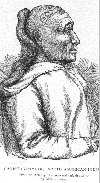
foreword | Historical Narratives | Resources | Links | Contact
ELIZABETH POSTHUMA SIMCOE, PART 2
History documents encounters between character and circumstance.
The five years Elizabeth Simcoe spent in Upper Canada - the most exciting in her long life - satisfied her every expectation.
In Her Own Words"To have everybody I see assiduous to please me and to have nothing to do but to follow my own fancy is a satisfactory mode of living. How happy I am!"
 |
So wrote the governor's wife of her existence in the genial society of which she was the centre. We owe a good deal to this serenely self-confident little lady whose pencil and paint brush have left us with a lively record of life in our province two centuries ago. Positive of her position and confidently talented, Elizabeth used pen and paint brush to provide a record that is exceptional for its diversity, detail and accuracy. Mrs. Simcoe kept three versions of her diary: the initial one was a brief daily record with rough sketches; the other two were expanded variations with greater detail and clearer writing. Fortunately this pioneer painter and writer had 'a picturesque eye' and a curiosity about all around her. With graphic words and water colours she described details about flora, fauna, meals and medicines - anything, in fact, that was a part of her world.
She was fascinated by the Native peoples as a group but showed less interest in others around her. With the exception of her son, Francis, who was obviously her favourite she provided relatively little personal information about her daughters or her husband whom she always referred to as "the Governor."
 |
|
Canise (Great Sail) etched by Mrs.Simcoe |
The Simcoes landed at Niagara at nine in the morning on Thursday, July 26th, 1792. They were determined to set off as quickly as possible to view the great cataracts whose powerful presence was revealled by a cloud they had seen while sailing to Newark. Its existence was betrayed by sound as well as sight for its awsome power could be heard at Navy Hall just "before rain when the wind is easterly."
It was with considerable excitement that the Simcoes set out for the Falls in their calashes at 8:00 a.m. on the Monday following their arrival at Niagara. They breakfasted with the Robert Hamiltons at their fine stone home in Queenston then ascended the steep road to the "top of the mountain" and proceeded south through the fine, flat countryside. Their hearts must have quickened when from a mile away they heard and felt the pounding power of the Falls. The rapids above the Falls were marvellous to see, but the Falls itself
In Her Own Words"Is the grandest sight imaginable particularly the circular form of the grand fall with its brightest green colour and the glorious rainbow hovering overhead."
Elizabeth could not get close enough to the cascading waters, and descended the steep hill to the table rock where the view was "tremendously fine." The prodigious spray rising from the foam created a wonderful "grandeur to the scene," the pleasures of which became "greater in dwelling upon them."
The danger of being carried over the Falls "without redress," was ever-present and there were numerous stories even then of individuals who had succumbed to the irresistible call of the current. Eight intoxicated soldiers had tempted fate and failed, their bodies found later some distance below the torrent. Another tragic victim was an Aboriginal who had tied his canoe to a tree on the shore of the river near Fort Schlosser and fallen asleep therein. While he slept someone cut the rope and the canoe eased into the river and was quickly carried into the rapids. Their roaring sounds awoke the sleeper who tried madly to paddle to the shore but despite his frenzied efforts he was unable to save himself from the raging waters. Realizing the futility of his frantic struggle he resigned himself to his fate, lay down in the canoe and within seconds disappeared into the maelstrom never to be seen again.
The Simcoes travelled past the foaming rapids to Fort Chippawa located beside a river of the same name, "a dull muddy river running through a flat, swampy country." Mrs. Simcoe was disappointed that they saw no rattlesnakes for she was fascinated and fearful of them. She encountered no end of "musquitos," whose bites caused her "exquisite pain" and severe swelling. An ever-present pest mosquitoes frequently made it
In Her Own Words"scarcely possible to write or use my hands which are always occupied in killing them."
On their return to Navy Hall the Simcoes were shocked to learn that Prince Edward, the father of Queen Victoria, was shortly to pay them a visit. Although they thought this untimely and most inconvenient they scurried about to prepare to welcome their eminent guest. Because unfinished Navy Hall smelled "atrociously of wet paint and damp plaster," they relinquished their comfortable tent to His Highness and made do themselves with the Hall where a despondent Elizabeth recorded
In Her Own Words"I sat by myself in a miserable, unfinished, damp room, looking on the lake, where it blew a gale, not a cheerful thought passing through my mind."
Pomp for the Prince required military displays including the ever-present firing of cannons. During one detonation Simcoe was standing too close to the cannon and the explosion temporarily deafened him. He was "seized with a violent pain in his head" which confined him to his bed and kept him from seeing the Prince for a fortnight. This new anguish cured another for the lingering "gouty pain" in his hand vanished only to be replaced by an ache in his head.
While she endeared herself to some of these people she alienated others, particularly colonists born in the United States who were embittered by her patronizing condescension. One of the latter was Hannah Jarvis, the feisty, outspoken wife of the provincial secretary. She hated Mrs. Simcoe for her wealth, selfishness and especially her influence over the "Governor," who, Hannah charged, had only married Elizabeth for her money. Hannah eagerly awaited Simcoe's recall so that they would be free once and for all from the "petticoat rule" they had to endure from the "stuttering little vixen." Mrs. Simcoe's feelings towards Mrs. Jarvis are not recorded since Elizabeth made a point of omitting from her diary anything unpleasant.
 |
|
Hannah Jarvis |
When Fort Niagara was eventually yielded to the Americans and Newark became vulnerable the looming presence of American cannons, Simcoe was forced to relocate the capital to Toronto. He made an exploratory trip to the forested shore and returned full of praise for its excellent harbour. Elizabeth said he was happy with the town site he had chosen amid a stand of great oaks. She visited the site herself on July 30th, 1793 and assisted in selecting a location "on rising ground" for their canvas house. The site they chose was close to the present Queen's Wharf at the southern end of Bathurst Street.
Mrs. Simcoe's fervor never flagged and she eagerly explored the peninsula which became Toronto Island when the lake broke through and severed the narrow sandbar in 1854. At the town site on the waterfront east of George Street Elizabeth watched as surveyor Alexander Aitkens laid out the first streets. From a small boat she then viewed the chalk cliffs of the bluffs they called Scarborough atop which she and the 'Governor' discussed building a summer home they would name Castle Frank. She explored "the creek which is to be called the River Don" and wherever she went was enthralled with the abundance of natural beauty which she sketched tirelessly.
Mrs. Simcoe, who was constantly on the move, was never intimidated by doubt, distance or weather. She visited widely "taking tea" at every opportunity as she travelled about her little kingdom quite confident of her own superiority.
In Her Own Words"I live with a set of people who, I am sure, do not know more than myself."
Copyright © 2013 Website Administrator